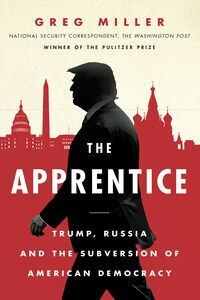William Collins
An imprint of HarperCollinsPublishers
1 London Bridge Street
London SE1 9GF
WilliamCollinsBooks.com
This eBook first published in Great Britain by William Collins in 2018
Copyright © 2018 by W P Company LLC
Cover design by Ploy Siripant; cover photographs © AFP/Getty Images (Trump); © by Phoelixde/Shutterstock (Russian skyline); © by Samiran Sarkar/Shutterstock (D.C. skyline); © Maxym/Shutterstock (texture)
Greg Miller asserts the moral right to be identified as the author of this work
A catalogue record for this book is available from the British Library
All rights reserved under International and Pan-American Copyright Conventions. By payment of the required fees, you have been granted the non-exclusive, non-transferable right to access and read the text of this e-book on-screen. No part of this text may be reproduced, transmitted, down-loaded, decompiled, reverse engineered, or stored in or introduced into any information storage and retrieval system, in any form or by any means, whether electronic or mechanical, now known or hereinafter invented, without the express written permission of HarperCollins
Source ISBN: 9780008325756
Ebook Edition © October 2018 ISBN: 9780008325763
Version: 2018-09-27
Contents
Cover
Title Page
Copyright
Dedication
Prologue
Part One
1. The Hack
2. Putin’s Trolls
3. Moths to the Flame
Part Two
4. “I Believe You Have Some Information for Us”
5. The Missing Emails
6. Crossfire Hurricane
7. Deep Inside the Kremlin
Part Three
8. Dezinformatsiya
9. The Russian Ambassador
10. Briefing the President
Part Four
11. You’re Fired
12. The Special Counsel Strikes
Part Five
13. “I Can’t Put on the Charm”
14. Helsinki
Epilogue
Plate Section
Notes
Index
Acknowledgments
About the Author
Also by Greg Miller
About the Publisher
THE WARREN OF CUBICLES WAS SECURED BEHIND A METAL door. The name on the hallway placard had changed often over the years, most recently designating the space as part of the Mission Center for Europe and Eurasia. But internally, the office was known by its unofficial title: “Russia House.”
The unit had for decades been the center of gravity at the CIA, an agency within the agency, locked in battle with the KGB for the duration of the Cold War. The department’s prestige had waned after the September 11 attacks, and it was forced at one point to surrender space to counterterrorism operatives. But Russia House later reclaimed that real estate and began rebuilding, vaulting back to relevance as Moscow reasserted itself. Here, among a maze of desks, dozens of reports officers fielded encrypted cables from abroad, and “targeters” meticulously scoured data on Russian officials, agencies, businesses, and communications networks the CIA might exploit for intelligence.
Deeper inside was a conference room adorned with Stalin-era posters of heroically depicted Soviets, muscled soldiers and workers striding across fields or factories under the hammer and sickle. The room, swept routinely for listening devices, was the scene of increasingly tense meetings in the months leading up to the 2016 presidential election, as senior agency officials sought to make sense of a series of disconcerting reports. In late July, the agency had gained access to an extraordinary stream of information showing that Russian president Vladimir Putin was himself directing the “active measures” operation aimed at disrupting the U.S. presidential race. U.S. intelligence partners were also warning Russia House about worrisome contacts between Russian figures and campaign associates of the Republican nominee.
Donald Trump’s vigorous displays of admiration for the Russian leader only made things more bewildering. He routinely praised Putin and even seemed to enlist Moscow in an effort to hack his opponent’s email account. The question was, why? Taking a hard line against Russia was the politically winning move, and yet Trump seemed subservient.
Unlike any presidential candidate in memory, Trump had shielded his finances from public scrutiny. He refused to release his personal tax returns. His business empire was a labyrinth of separate companies registered under different names. Many of those he had done business with hid their identities behind corporate shells. Some of his most prominent developments were deep in debt, though how deep and to whom was nearly impossible to discern.
During the campaign, there was consolation in the idea that Trump’s unsettling behavior toward Moscow was a product of inexperience—a problem that would be contained when he was surrounded by smarter advisers or wouldn’t matter anymore once he lost. But those inside U.S. spy agencies were privy to alarming secrets that were not so easily shrugged off. Among them was that the Kremlin was actively seeking to help elect Trump.
Russia House was the point of origin for that assessment, which would later be embraced by the U.S. intelligence community and infuriate the 45th president. The Kremlin’s objectives began with sowing discord in American democracy, but broadened in mid-2016 to backing a specific candidate—who at this moment, his second day as leader of the free world, was making his way toward CIA headquarters.








